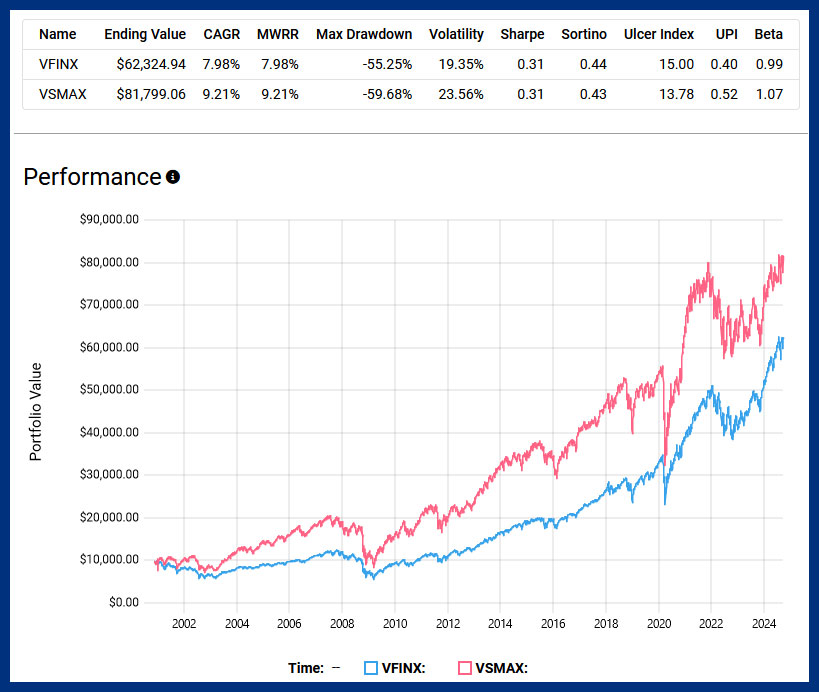Boost your portfolio: Why and how to increase small-cap exposure with ETFs
What small-capitalization stocks can add to your portfolio and how much you should allocate to them. Plus, we identify some of the best low-cost, small-cap ETFs.
Advertisement
What small-capitalization stocks can add to your portfolio and how much you should allocate to them. Plus, we identify some of the best low-cost, small-cap ETFs.

Market-cap weighted indices like the CRSP US Total Market Index, which is tracked by the Vanguard U.S. Total Market Index ETF (VUN), exhibit an interesting quirk by design: an underweight to small-cap stocks. This methodology reflects the natural weighting of the market, where large caps dominate due to their sheer size (share price times shares outstanding). Yet, it’s important not to overlook small-capitalization stocks.
Interestingly, small-cap stocks have historically outperformed their larger counterparts and, if academics are to be believed, will continue to do so over the long term. Don’t let recency bias sway you; the dominance of mega-cap stocks over the last decade isn’t the whole story.
Market cap, short for market capitalization, is the total market value of a company’s outstanding shares, or stocks. To calculate market cap, multiple the number of shares by the market price of one share. (For example, a company with 10 million shares priced at $25 each has a market cap of $250 million.) People in the investing community use market cap to indicate a company’s value and compare its size relative to others in the same industry or sector. Stock exchanges and cryptocurrencies also have a market cap.
Read more in the MoneySense Glossary of Investing terms: What is a market cap?
When it comes to the stock market, there are certain formulas, known as asset pricing models, that help us understand why stocks move the way they do. You might have heard of one called CAPM, or the Capital Asset Pricing Model. Basically, CAPM tells us that the return you should expect from a stock is tied to how risky it is compared to the whole market. It’s like saying, the riskier the stock, the bigger the potential reward should be.
Here’s the twist: CAPM doesn’t reveal the whole story. It misses out on some other factors that can also affect a stock’s performance. Back in the 1990s, two professors from the University of Chicago, Eugene Fama and Kenneth French, added more layers to this model. It’s called the Fama-French three-factor model. It later grew into a five-factor model, but to keep it simple, let’s go with the original three:
So, focusing on the size factor, it explains why, over time, these smaller companies, or “small caps” as we call them, might give you better returns than the giants of the stock world.

To understand the performance dynamics between large- and small-cap stocks, we can examine two older U.S. index-based mutual funds: the Vanguard 500 Index Fund Admiral Shares (VFIAX), which tracks the S&P 500, and the Vanguard Small-Cap Index Fund Admiral Shares (VSMAX).
We’ll use a back-test period from November 14, 2000, to September 19, 2024. This timeline is particularly insightful as it includes several major market events: the dot-com bust, the 2008 financial crisis, the COVID-19 pandemic and the ensuing bull market primarily driven by technology stocks.
During this period, small caps, represented by VSMAX, outperformed the S&P 500, as tracked by VFIAX. The Compound Annual Growth Rate (CAGR) for VSMAX stood at 9.21% compared to 7.98% for VFIAX. However, this higher return came with increased volatility and larger drawdowns (price drops from peak to trough).
On a risk-adjusted basis, the performance of both funds essentially leveled out with an identical 0.31 Sharpe ratio, meaning that investors in VSMAX were compensated more or less fairly for the higher risk associated with small-cap investments.
When it comes to allocating to small caps, I’m going to take a somewhat contrarian stance and suggest that most people might actually want to steer clear. It’s no free lunch.
Adding small caps to your portfolio introduces higher volatility and complexity and, critically, their outperformance isn’t guaranteed. As we’ve seen over the last decade, small caps can underperform for extended periods, and not many investors have the stomach to stick with them through such troughs.
However, if you’re keen on incorporating small caps into your investment strategy—perhaps you’re drawn to the potential of factor investing—then it’s wise to approach this without a rigid formula. I recommend the “core-satellite” method.
Here’s how it works: You keep the bulk of your portfolio focused on broad market exposure through low-cost, “cheap beta” options, like the S&P 500. Then, allocate 10% to 20% to small caps for a “value tilt.”
When exploring small-cap exchange-traded funds (ETFs), Canadian investors may find the domestic market a bit lacking. The choices are fewer and generally more expensive compared to their U.S.-listed counterparts.
For example, according to the Cboe Canada ETF screener, the most budget-friendly option available looks to be the First Trust SMID Cap Rising Dividend Achievers ETF (SDVY), charging a management expense ratio of 0.15%. On the pricier side, there’s the actively managed Fidelity Global Small Cap Opportunities Fund (FCGS) with a hefty fee of 1.13%. Given these small sizes in terms of assets under management and high costs, these options might not be ideal for every Canadian investor.
Given this scenario, looking to U.S. markets for small-cap exposure could be more fruitful. Vanguard, known for its cost-efficient funds, offers the Vanguard Small-Cap Index Fund ETF (VB) at a very low expense ratio of 0.05%. This ETF tracks the CRSP US Small Cap Index.
For those inclined towards more renowned indexes, the iShares Russell 2000 ETF (IWM) and iShares Core S&P Small-Cap ETF (IJR) are notable mentions, costing 0.19% and 0.06% respectively. Among these, IJR has historically shown superior performance. It tracks the S&P 600, a small-cap index that uses a quality screen to filter stocks based on earnings strength.
Finally, for Canadian investors interested in active management at a reasonable cost, firms like Avantis Investors and Dimensional Fund Advisors seems to stand out. Both firms have solid reputations and are renowned for their strong factor investing approaches. Key ETFs that might be worth considering include the Avantis U.S. Small Cap Equity ETF (AVSC) and Dimensional US Small Cap ETF (DFAS), with expense ratios of 0.25% and 0.26%, respectively.
Share this article Share on Facebook Share on Twitter Share on Linkedin Share on Reddit Share on Email
On the Canadian front there is XCS. Sure it has an MER of 60bp, but in a field of few choices it’s better than the active managed fund mentioned.